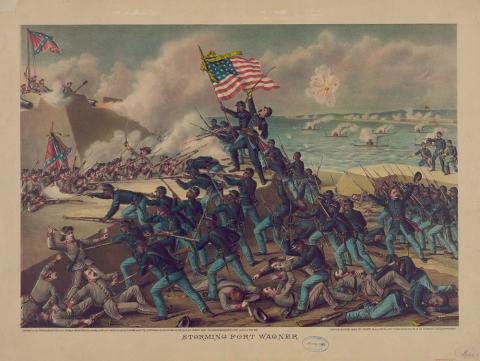Image

Description
Published July 5, 1890, this colored lithographic print shows the 54th Massachusetts Volunteer Infantry Regiment, led by Colonel Robert Gould Shaw, storming the walls of Fort Wagner on Morris Island, South Carolina, and engaging Confederate soldiers in brutal hand-to-hand combat. The 54th spearheaded this July 18, 1863, assault and received a high number of casualties. Both Shaw and William Carney, the first African-American recipient of the Congressional Medal of Honor for his actions in recovering and returning the unit’s American flag, are portrayed in the center of the image as leaders of the charge.
Source-Dependent Questions
- What might the efforts of the 54th Massachusetts have proven to those who were skeptical of the Union’s enlistment of African-American combat soldiers? What evidence in the image leads you to believe this?
- Included in this illustration are Colonel Robert Gould Shaw, who led the 54th Massachusetts Volunteer Infantry Regiment, and William Carney, the first African-American recipient of the Congressional Medal of Honor. Explain why these men are prominently placed in the center of this image.
- Considering this image was created 27 years after the assault on Fort Wagner, why did the artist create it? Also, using evidence from the image, explain whether or not he was successful in achieving his purpose.
- How might the fact that this painting was completed so long after the actual event occurred impact your evaluation of it?
Citation Information
Kurz & Allison, "Storming Fort Wagner," 5 July 1890. Courtesy of Library of Congress